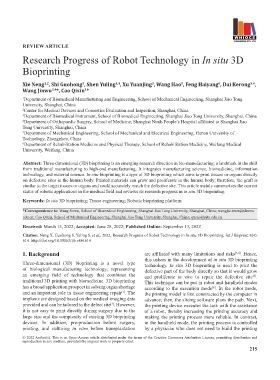Page 223 - IJB-8-4
P. 223
REVIEW ARTICLE
Research Progress of Robot Technology in In situ 3D
Bioprinting
Xie Neng , Shi Guohong , Shen Yuling , Xu Yuanjing , Wang Hao , Feng Haiyang , Dai Kerong ,
3,4
5
3
6
3,4
3
1,2
Wang Jinwu *, Cao Qixin *
3,4
1
1 Department of Biomedical Manufacturing and Engineering, School of Mechanical Engineering, Shanghai Jiao Tong
University, Shanghai, China
2 Center for Medical Devices and Cosmetics Evaluation and Inspection, Shanghai, China
3 Department of Biomedical Instrument, School of Biomedical Engineering, Shanghai Jiao Tong University, Shanghai, China
4 Department of Orthopaedic Surgery, School of Medicine, Shanghai Ninth People’s Hospital affiliated to Shanghai Jiao
Tong University, Shanghai, China
5 Department of Mechanical Engineering, School of Mechanical and Electrical Engineering, Henan University of
Technology, Zhengzhou, China
6 Department of Rehabilitation Medicine and Physical Therapy, School of Rehabilitation Medicine, Weifang Medical
University, Weifang, China
Abstract: Three-dimensional (3D) bioprinting is an emerging research direction in bio-manufacturing, a landmark in the shift
from traditional manufacturing to high-end manufacturing. It integrates manufacturing science, biomedicine, information
technology, and material science. In situ bioprinting is a type of 3D bioprinting which aims to print tissues or organs directly
on defective sites in the human body. Printed materials can grow and proliferate in the human body; therefore, the graft is
similar to the target tissues or organs and could accurately match the defective site. This article mainly summarizes the current
status of robotic applications in the medical field and reviews its research progress in in situ 3D bioprinting.
Keywords: In situ 3D bioprinting; Tissue engineering; Robotic bioprinting platform
*Correspondence to: Wang Jinwu, School of Biomedical Engineering, Shanghai Jiao Tong University, Shanghai, China; wangjw-team@shsmu.
edu.cn; Cao Qixin, School of Mechanical Engineering, Shanghai Jiao Tong University, Shanghai, China; qxcao@sjtu.edu.cn
Received: March 15, 2022; Accepted: June 28, 2022; Published Online: September 13, 2022
Citation: Neng X, Guohong S, Yuling S, et al., 2022, Research Progress of Robot Technology in In situ 3D Bioprinting. Int J Bioprint, 8(4):
614. http://doi.org/10.18063/ijb.v8i4.614
1. Background are affiliated with many limitations and risks [3,4] . Hence,
this ushers in the development of in situ 3D bioprinting
Three-dimensional (3D) bioprinting is a novel type technology. In situ 3D bioprinting is used to print the
of biological manufacturing technology, representing defective part of the body directly so that it would grow
an emerging field of technology that combines the and proliferate in vivo to repair the defective site .
[5]
traditional 3D printing with biomedicine. 3D bioprinting This technique can be put in robot and handheld modes
has a broad application prospect in solving organ shortage according to the execution mode . In the robot mode,
[6]
and an important role in tissue engineering repair . The the printing model is first constructed by the computer in
[1]
implants are designed based on the medical imaging data advance; then, the slicing software plans the path. Next,
provided and can be tailored to the defect site . However, the printing device executes the task with the assistance
[2]
it is not easy to print directly during surgery due to the of a robot, thereby increasing the printing accuracy and
large size and the complexity of existing 3D bioprinting making the printing process more reliable. In contrast,
devices. In addition, pre-production before surgery, in the handheld mode, the printing process is controlled
printing, and culturing in vitro before transplantation by a physician who does not need to build the printing
© 2022 Author(s). This is an Open-Access article distributed under the terms of the Creative Commons Attribution License, permitting distribution and
reproduction in any medium, provided the original work is properly cited.
215

